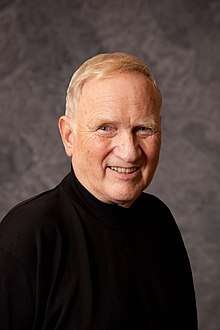John Clauser
John Francis Clauser (/ˈklaʊzər/; born December 1, 1942) is an American theoretical and experimental physicist known for contributions to the foundations of quantum mechanics, in particular the Clauser–Horne–Shimony–Holt inequality.[1]
John Clauser | |
|---|---|
 | |
| Born | John Francis Clauser 1 December 1942 Pasadena, U.S. |
| Alma mater | Columbia University |
| Known for | Bell test experiments, CHSH inequality |
| Awards |
|
| Scientific career | |
| Fields | Foundation of quantum mechanics |
Biography
Clauser was born in Pasadena, California. He received his B.S. in physics from the California Institute of Technology in 1964. He received his M.A. in physics in 1966 and his Ph.D. in physics in 1969 from Columbia University.[1]
From 1969 to 1996, he worked mainly at Lawrence Berkeley National Laboratory, Lawrence Livermore National Laboratory, and the University of California, Berkeley.[1]
Clauser was awarded the Wolf Prize in Physics in 2010 together with Alain Aspect and Anton Zeilinger. In 1972, working with Stuart Freedman, he carried out the first experimental test of the CHSH-Bell's theorem predictions. This was the first experimental observation of a violation of a Bell inequality.
In 1974, working with Michael Horne, he first showed that a generalization of Bell's Theorem provides severe constraints for all local realistic theories of nature (a.k.a. objective local theories). That work introduced the Clauser–Horne (CH) inequality as the first fully general experimental requirement set by local realism. It also introduced the "CH no-enhancement assumption", whereupon the CH inequality reduces to the CHSH inequality, and whereupon associated experimental tests also constrain local realism. Also in 1974 he made the first observation of sub-Poissonian statistics for light (via a violation of the Cauchy–Schwarz inequality for classical electromagnetic fields), and thereby, for the first time, demonstrated an unambiguous particle-like character for photons. In 1976 he carried out the world's second experimental test of the CHSH-Bell's Theorem predictions.